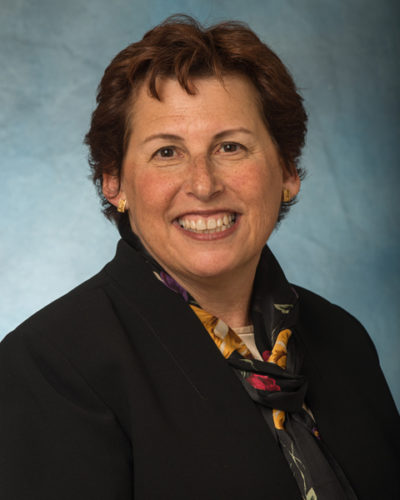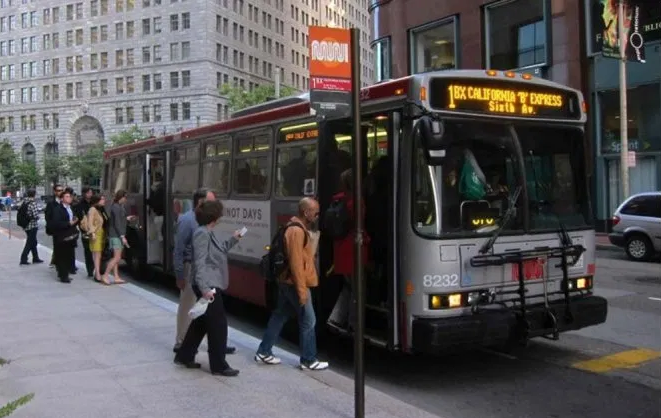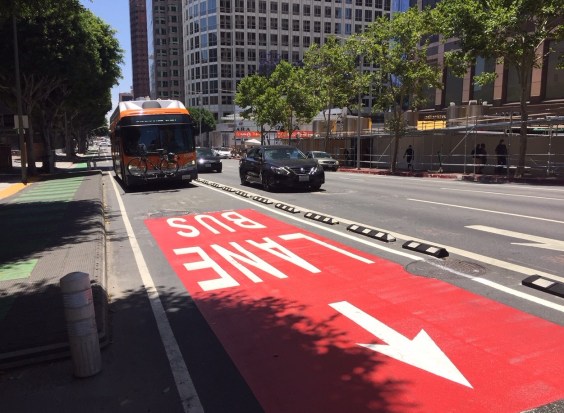New Caltrans Executive Director Laurie Berman Speaks of Changes Afoot at the State DOT
12:36 PM PST on November 6, 2018

Laurie Berman, Director of California Department of Transportation. Image courtesy Caltrans.
Note: GJEL Accident Attorneys regularly sponsors coverage on Streetsblog San Francisco and Streetsblog California. Unless noted in the story, GJEL Accident Attorneys is not consulted for the content or editorial direction of the sponsored content.
Last March, California's Department of Transportation, better known as Caltrans, got a new executive director. Laurie Berman is an engineer who has spent her entire career at Caltrans, most recently as director of District 11, which spans the state's southern border with Mexico. She's the first female engineer to hold the top post at Caltrans, and she joins a growing list of women leaders who are joining the department and helping shift its focus from cars to transportation for everyone.
The department is a behemoth, encompassing more than 18,000 employees in twelve large districts who engineer, design, plan, build, and maintain 50,000-plus miles of state highways, many of them streets that cross cities and towns.
As reported by Streetsblog over the last few years, Caltrans has begun acknowledging that calling itself “the highway department” has severely limited how it serves the transportation needs of all Californians. It has reworked its mission statement; it created a division specifically focused on increasing its sustainable practices and contributing to a sustainable transportation system; it created a new position of pedestrian and bicycle safety chief. The longstanding and ineffective California Bicycle Advisory Committee has been revamped into a walk/bike advisory committee that solicits input from a wider range of people.
Streetsblog sat down recently to talk with the new Caltrans director about her job. The conversation ranged widely, covering the shifting culture at Caltrans, the department's goals to get more people using environmentally benign transportation modes, climate change, induced demand, and changing California's built environment.
Culture Change at Caltrans
Berman was both optimistic and realistic about making Caltrans better. She believes the department is changing faster that might be expected. Although at first some planners and engineers didn't see the point of considering the needs of pedestrians and bicyclists and transit riders, “it really has not taken a generation of people to start implementing that,” she said.
For example, when headquarters began incorporating the concepts of Complete Streets—in which all users of a road are considered in its design, not just car drivers with others crammed in as afterthoughts—rather than meeting resistance, Berman believes it gave engineers and planners "permission" to think more broadly about transportation.
She gave two examples, both of them from her work in District 11. A project to widen I-5, in San Diego's North Coast Corridor, became, according to Berman, “a model of how you build an integrated system.”
“We're adding an express lane; we're double-tracking the rail, so that the transit agencies can improve rail times. We're adding bike lanes and bike paths, and we're improving the bike access from east county to the coastline—because when we built I-5 in the '70s, we weren't worried about that part,” she said. “The project has everything.”
At one point something happened that, she said, “was an indicator for me that we were turning the corner.” The project required a very high retaining wall, an engineering challenge. “It's hard to build a wall as high as it needed to be,” she said, “so the engineers said: okay, we're going to split the wall halfway up. There will be a wall, then a bench, and then the rest of the wall.”
Then they realized that, simply by making the bench area wider, they could accommodate a bike path. “All of a sudden we have a bike path that we hadn't even planned on,” she said. “That was kind of an 'aha' moment, when we realized we could do more than just widen the road, in the process of realizing one of our objectives.” Thus a giant wall designed to hold back a hillside became the foundation for bike access.
The other example comes from Imperial County.“We had a weird situation where we were shutting down part of I-8 and moving drivers over” to accommodate paving work, she said. “The contractor said he felt it would be safer if he could move all the traffic to a county road, but that was falling apart. So we talked about it, and he figured out a way to bring it up to a good enough standard to accommodate interstate traffic for a year or two.”
“The really good part,” she said, “is now that we're done, it's a county road again, but it's a county road that's not falling apart. Meanwhile the local cycling community that was asking us for better shoulders on I-8 now have a separate county road for several miles through Imperial County.”
What she appreciated about the process there, said Berman, was that the primary goal was worker's safety--“that's what kind of drove the decisions, along with safety for the traveling public. And then at the end, we end up with a bike path.”
Berman said those “aha” moments are happening throughout the state, as engineers are beginning to reckon with what it means to accommodate everyone in their highway building process.
Of course it's not happening at every level, and there are plenty of counterexamples where Caltrans and city engineers have resisted putting in good bike or pedestrian infrastructure because it impinges on car traffic. But Berman remains optimistic that change will come.
“It's a work in progress,” she said. “Not everyone's going to like everything we do, and sometimes we won't quite hit it. But there are still opportunities to go back and fix some things,” she said. “I hope by and large we're going back and getting it right.”
That's why the bike pedestrian advisory groups are so important, she added.
So is training current Caltrans employees and hiring new ones that are knowledgeable about complete streets concepts. The recently launched Complete Streets Center of Excellence will also be key. The center will bring together Caltrans planners and engineers who have experience planning and building complete streets projects to build on and share their skills and knowledge. Then those trained-and-certified Complete Streets champions will be available to support and advise Caltrans staff throughout the state.
Berman is excited about the possibilities stemming from this work. “We've gone from being heavily criticized for not knowing anything about Complete Streets to establishing a Center of Excellence, and providing tools that we can all use, statewide, to move forward together and build facilities that are useful to everyone.”
Climate Change Is Here, Now
One of the main reasons Caltrans is making this shift away from its traditional focus on cars is because the state has recognized that climate change is here. Caltrans wants to encourage more sustainable transportation modes--but also it is already dealing with climate change's effects.
“Climate change is affecting us in big ways that are completely impossible to ignore,” said Berman. “All summer long I had people in Redding, in the Mendocino area, involved in firefighting--saving our facilities, working with first responders to close the roads, getting the roads ready to reopen.” Since June is not usually fire season in California, that expense of time and resources was unanticipated.
“We can't ignore what's happening,” she said.
In response to this and other events, like mudslides that closed highways in Santa Barbara and near Big Sur in the last few years, Caltrans' Sustainability Division has begun planning for climate risks to the state highway system, developing a Climate Change Vulnerability Assessment for each district. “We've got places where sea level rise is already impacting some of our facilities,” said Berman. “It will continue to do that. As we identify those areas, as we continue to build projects and maintain the system, we need to realize that Mother Nature is not backing off.”
“We're spending a fortune recovering from fires and floods,” she said. “Where we had the fires this summer, we're getting ready for the mudslides that will come this winter--assuming we get rain. If we don't get rain, we have to consider: are we going to be back in a drought period? What is that going to do to the trees? We've lost thousands and thousands of trees statewide, which also presents a threat to our system, because in some cases we can't remove them fast enough.”
Becoming more sustainable as a department encompasses everything from electric vehicles—replacing the state fleet, encouraging employees to buy them, helping plan and build a statewide charging network—to pavement materials and lighting. For example, Caltrans is now using a highly reflective material on its signs so they don't need any lighting at all.
Berman says that overall Caltrans is taking a more holistic approach. “With the project I mentioned in San Diego along the North Coast Corridor,” she said, “We're leaving the coastline in better health than we found it--we're actually improving the health of the lagoons.”
Induced Demand
When asked about highway building and induced demand—the idea that building wider highways will invite more driving, thus erasing any potential congestion benefits—she responded, “I think we could have that debate—is it induced? is it latent? But here's the thing: people are going to keep moving to California, and we can't keep expanding the roads. We have to get people onto other modes of transportation, and we've got to make it easy to make that mode shift--and we've got to make it easy to have a seamless shift between modes.”
“Whether there's induced demand or not, I don't see us expanding the freeway system the way we have done for years. We're out of room, but we're not out of people. What's really important for Caltrans is recognizing that all people need to get around and we still need to move goods around in a way that makes sense.”
Public Transit
Sustainable transportation requires good public transit, but California's system is piecemeal and disconnected. Caltrans' main role in terms of public transit has been through providing and guiding funding, and creating statewide plans like the State Rail Plan and by encouraging efforts like the California Integrated Travel Conference.
“I lived in San Diego for a long time, but it never used to occur to me to jump on the train to go to LA.,” said Berman. But now she has experienced that train ride, “and I'm not getting in my car to go to L.A.--there's no way.”
“We need to help people understand that it's not that hard, and there's a benefit” to taking transit, she said. “People are going to go with what's easy. Some days maybe I do need to drive; a lot of days maybe it's easier to take the train, and I just need to know how simple that is, and I need to understand how to get from Amtrak to Metrolink or vice versa.”
“That's where the state can help local transit agencies,” she said, “by helping provide that interoperability, that ease.”
In California, however, that interoperability is still rare. For every trip like the one this writer took--biking to a train and then biking on the other end to this meeting--there are more where trying to transfer between agencies that run similar or connecting services is difficult to impossible.
More Biking, Walking, and Transit Trips
Caltrans also set those famous mode shift goals—to triple biking trips and double walking and transit trips by 2020, which is two short years away. Are we going to make those goals?
“That was a big lift,” said Berman of the goals, set in 2016. “I'll be honest, we're not showing that we're getting there as quickly as we wanted to—but that doesn't mean we stop. It means we look at what's impacting our ability to get there.” That includes studying network gaps, addressing safety, and “working with local partners to build out facilities through the Active Transportation Program. I think when you have greater connectivity, you'll have more people riding.”
“And then there's these other things that have come up that we couldn't have predicted,” she added. Scooters and bike-share, for example. “Jump bikes are all over Sacramento, and people are using them like crazy.”
“People want it to be easy,” said Berman. “I really think as we continue to build out more opportunities for cycling, it'll be easier for people. As they begin to see that there's greater connectivity on transit as well, then they'll use it more.”
“It's better to be able to say: 'here are your options,' rather than: 'okay, now you want to ride your bike, so now we'll start building the system.'”
The Built Environment
It somewhat of a trope that it's hard/expensive/slow to change the built environment; we've built our cities and highways to handle traffic etc. in a particular way, goes the thinking, and now we're stuck with it. But, says Berman, the built environment is actually not that hard to change—and it is changing anyway.
“I'll go back to my example in San Diego,” she said. “On that North Coast project, we're lengthening the bridges to improve tidal flow. We don't have to. When we built the system in the '60s and '70s, we built the bridges as short as we could because it was cheaper. But now we're looking at what else we are impacting.”
Into the Future
“It's a very exciting time to be working in transportation,” said Berman. “We're going through a big revolution in ways that we can't control or predict, and it's making people uneasy. You see people that are angry about scooters—it's amazing how angry people are about scooters.”
Green painted and parking-protected bike lanes, roundabouts, bike-share—communities are undergoing changes that can be confusing and sometimes upsetting. “It's forcing us all to be a little more cautious, no matter what mode you're using, to be a little more aware of what's around you,” said Berman. “People get really excited about it, and are worried that we're taking away their cars.”
“But we're not trying to take away anybody's car. We just want to make sure that there's room for everybody.”
“I'm very proud of what we're doing at Caltrans,” Berman concluded. “I've been here my entire career and I find it very exciting. I'm excited for the new engineers and planners that are coming to work here, because these are such new and different issues, and they're going to have a chance to study and create the transportation world of the future.”
Because what it comes down to, she said, is finding a way to move goods and people around and through the state while addressing climate change and other issues that have to be addressed. “I hope that people feel the benefit of the work we do here,” she said.
Berman has one more reminder for any reader who might still be traveling by that old fashioned mode, the car. “I have a lot of people out there working, night and day, so if you happen to be driving, please watch out for them," she said. "We really need everybody to pay attention in order to have a safe transportation system.”
Streetsblog California editor Melanie Curry has been thinking about transportation, and how to improve conditions for bicyclists, ever since commuting to school by bike long before bike lanes were a thing. She was Managing Editor at the East Bay Express, editor of Access Magazine for the University of California Transportation Center, and earned her Masters in City Planning from UC Berkeley.
Read More:
Stay in touch
Sign up for our free newsletter
More from Streetsblog California
Thursday’s Headlines
LA Metro declares emergency over attacks on bus operators; Some deadly Bay Area streets to see safety fixes; Tax ride-hail to save transit? More
Bill to Require Speed Control in Vehicles Goes Limp
Also passed yesterday were the Complete Streets bill, a bill on Bay Area transit funding, and a prohibition on state funding for Class III bikeways.
‘We Don’t Need These Highways’: Author Megan Kimble on Texas’ Ongoing Freeway Fights
...and what they have to teach other communities across America.
Wednesday’s Headlines
Brightline LA-to-Vegas promises quick construction; LA Metro buses set to test camera enforcement of bus lane obstruction; Why are we still knocking down houses to build freeways? More
Brightline West Breaks Ground on Vegas to SoCal High-Speed Rail
Brightline West will be a 218-mile 186-mile-per-hour rail line from Vegas to Rancho Cucamonga - about 40 miles east of downtown L.A. - expected to open in 2028




